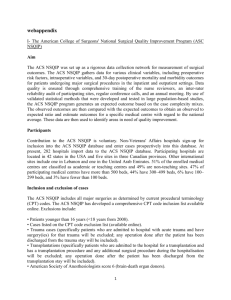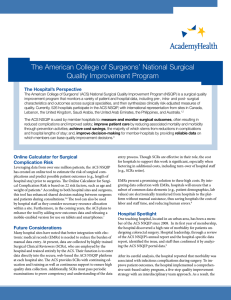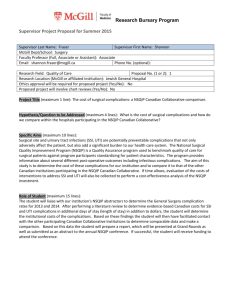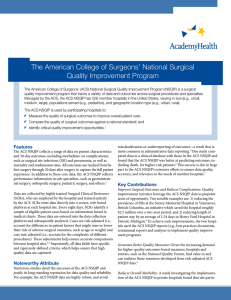The American College of Surgeons’ (ACS) National Surgical
advertisement
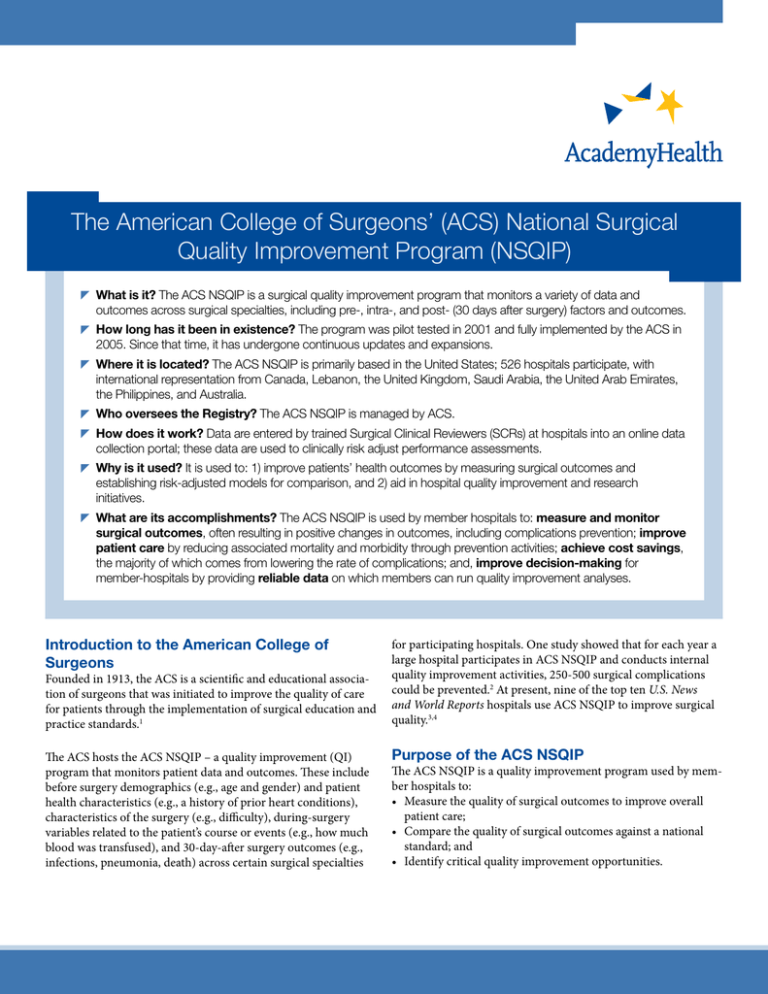
The American College of Surgeons’ (ACS) National Surgical Quality Improvement Program (NSQIP) What is it? The ACS NSQIP is a surgical quality improvement program that monitors a variety of data and outcomes across surgical specialties, including pre-, intra-, and post- (30 days after surgery) factors and outcomes. How long has it been in existence? The program was pilot tested in 2001 and fully implemented by the ACS in 2005. Since that time, it has undergone continuous updates and expansions. Where it is located? The ACS NSQIP is primarily based in the United States; 526 hospitals participate, with international representation from Canada, Lebanon, the United Kingdom, Saudi Arabia, the United Arab Emirates, the Philippines, and Australia. Who oversees the Registry? The ACS NSQIP is managed by ACS. How does it work? Data are entered by trained Surgical Clinical Reviewers (SCRs) at hospitals into an online data collection portal; these data are used to clinically risk adjust performance assessments. Why is it used? It is used to: 1) improve patients’ health outcomes by measuring surgical outcomes and establishing risk-adjusted models for comparison, and 2) aid in hospital quality improvement and research initiatives. What are its accomplishments? The ACS NSQIP is used by member hospitals to: measure and monitor surgical outcomes, often resulting in positive changes in outcomes, including complications prevention; improve patient care by reducing associated mortality and morbidity through prevention activities; achieve cost savings, the majority of which comes from lowering the rate of complications; and, improve decision-making for member-hospitals by providing reliable data on which members can run quality improvement analyses. Introduction to the American College of Surgeons for participating hospitals. One study showed that for each year a large hospital participates in ACS NSQIP and conducts internal quality improvement activities, 250-500 surgical complications could be prevented.2 At present, nine of the top ten U.S. News and World Reports hospitals use ACS NSQIP to improve surgical quality.3,4 The ACS hosts the ACS NSQIP – a quality improvement (QI) program that monitors patient data and outcomes. These include before surgery demographics (e.g., age and gender) and patient health characteristics (e.g., a history of prior heart conditions), characteristics of the surgery (e.g., difficulty), during-surgery variables related to the patient’s course or events (e.g., how much blood was transfused), and 30-day-after surgery outcomes (e.g., infections, pneumonia, death) across certain surgical specialties Purpose of the ACS NSQIP Founded in 1913, the ACS is a scientific and educational association of surgeons that was initiated to improve the quality of care for patients through the implementation of surgical education and practice standards.1 The ACS NSQIP is a quality improvement program used by member hospitals to: • Measure the quality of surgical outcomes to improve overall patient care; • Compare the quality of surgical outcomes against a national standard; and • Identify critical quality improvement opportunities. 2 | The American College of Surgeons’ National Surgical Quality Improvement Program History and Development of the ACS NSQIP The current program was modeled after a U.S. Department of Veterans Affairs (VA) pilot initiative that was established in 1994 to evaluate surgical quality and identify areas for improvement within VA hospitals. In 2001, the Agency for Healthcare Research and Quality (AHRQ) provided funding for the ACS to deploy a pilot program (based on the VA experience) to evaluate surgical quality within 12 private sector hospitals. This program, which ran from 2001 to 2004, leveraged the methodology applied in the VA initiative. The program was well received, and in 2005 the ACS began enrolling additional private sector hospitals. With input from experts in the field, the ACS has continued to shape and expand the program, now referred to as the “ACS NSQIP”.5 Information (Data) Included in the ACS NSQIP The ACS NSQIP currently collects a range of data on patient characteristics and 30-day outcomes, including morbidities (or complications), such as surgical site infections (SSI) and pneumonia, as well as mortality and other items such as readmission rates. All outcomes are tracked from before surgery through 30 days after surgery to capture the full patient experiences, including complications. In addition to these core data, the ACS NSQIP collects additional performance information in sub-specialties, such as gastrointestinal surgery, orthopedic surgery, pediatric surgery and others.6 Data are collected by highly trained SCRs who are employed by the hospital and trained entirely by the ACS. SCRs enter data directly into a secure, web-based platform at each hospital site. Every eight days, SCRs identify a sample of eligible patient cases based on information found in medical charts that is then entered into the data collection platform and subsequently analyzed. The ACS NSQIP evaluations are then risk-adjusted (i.e., accounting for differences in patient factors that might raise or lower their risk of adverse surgical outcomes, such as age or weight) and case mix-adjusted (i.e., accounting for the complexity of different procedures). These adjustments help ensure accurate comparisons across hospital sites.7,8 Importantly, all data fields are associated with rigorous definitions and criteria, helping ensure the “quality” of the data points themselves. The ACS provides SCRs with continuing education and training as well as continuous support to ensure capture of high quality data. SCRs must also pass periodic examinations. Data quality checks, such as audits of a data samples found in patient medical records and those entered into the ACS NSQIP, are built into the platform and conducted regularly by the ACS. Participation Options All participating hospitals report to the ACS NSQIP on a general set of defined data.9 In 2010, the ACS NSQIP established a set of expanded participation options, which are designed to collect a variety of data fields depending on hospitals’ needs; in particular, these expanded options help satisfy the requirements of the increasingly diverse membership base of large health systems as well as small rural critical access sites.10 Options include: • Small and Rural: for hospitals with fewer than 1,680 eligible surgical cases per year; • Essential: for hospitals with a minimum of 1,680 eligible surgical cases per year; • Procedure-targeted: for specialty hospitals with a focus on high volume, high-risk procedures; • Measures Option: for hospitals focused on a specific set of outcomes; and • Pediatric: for hospitals focused on child and pediatric care.11 If a hospital chooses an expanded option, it must report both the general and expanded set of data. In turn, the hospital receives multiple risk-adjusted reports that can be used to inform care improvements.12 Management and Governance The ACS NSQIP operates under the ACS’s Division of Research and Optimal Patient Care. The ACS NSQIP Advisory Committee advises ACS leadership on topics such as hospital recruitment, policy considerations, and opportunities for quality improvement within the program. The Advisory Committee also provides input to the ACS Quality Committee on the current state of and outlook for the ACS NSQIP. The ACS NSQIP also receives guidance from ACS policy and advocacy experts. The SCR Advisory Council, a group of highly motivated and expert SCRs from a sample of hospital sites, regularly advises the ACS on data collection issues faced by participating hospitals. In recent years, the ACS NSQIP Advisory Committee chartered the Expansion Work Group Committee, whose charge is to promote the ACS NSQIP’s value to non-participating hospitals and recruit additional members.13 Funding The ACS NSQIP is supported by the ACS, a not-for-profit organization, and by member hospitals’ annual fees. These fees range from $10,000 to $29,000, depending on the membership option and the cost to cover the program’s management and administration, training for SCRs, on-site audits, the installation of the ACS NSQIP platform, and ongoing technical support.14 Noteworthy Attributes Robust Data and Methodology Numerous studies detail the successes of the ACS NSQIP and justify its long-standing reputation for data quality and reliability. For example, its data are highly robust and less prone to misclassification or underreporting of outcomes than administrative data.15 One study compared data found in a clinical database with those in the ACS NSQIP and found that the ACS NSQIP was better at predicting outcomes, including death, for higher-risk patients.16 3 | The American College of Surgeons’ National Surgical Quality Improvement Program This success is due in large part to the ACS NSQIP’s extensive efforts to ensure data quality, accuracy, and relevance to the needs of its hospitals. Further, the program has developed statistical methodologies used for analyses, such as risk adjustment.17 The ACS NSQIP’s risk-adjustment process allows for data to be nationally benchmarked so that members can compare results to similar patients and hospitals.18,19,20 Highly Effective Training and Auditing Services Members regularly cite that the training for SCRs and data auditing services provided by the ACS NSQIP are beneficial to their internal efforts. Once a hospital becomes a member, the ACS NSQIP Clinical Support Team leads an initial training for the designated SCR. This initial training session lasts approximately four weeks, during which time the ACS provides thorough review of data entered in the platform for the first 80-100 patient cases by the new SCR. At the end of the training, the SCR completes a test to ensure full understanding of the program and the data entry process.21 Additionally, SCRs receive ongoing support from the ACS NSQIP nurse coordinators, who periodically test staff to ensure comprehensive understanding of the program and hold weekly conference calls to discuss issues encountered in data collection, data analyses, and quality improvement activities.22 The ACS NSQIP nurse coordinators also conduct follow-up site visits with SCRs approximately six months after the initial training session to review processes, provide continuing education programs, and perform an inter-rater reliability audit, where two or more SCRs code an identical set of patients which are then analyzed for similarities and differences.23 Interrater Reliability Study From 2005 through 2008, the interrater reliability was carefully tracked for all ACS NSQIP auditing services. Analyses showed that overall disagreement rates fell from 3.15 percent in 2005 to 1.56 percent in 2008. Furthermore, the audit results have shown that data are reliable.24 Access to Learning Collaboratives Another benefit of the program is access to learning collaboratives, or groups of member hospitals where participants learn from one another and share best practices for quality improvement. These collaboratives are often organized around geographic location (e.g., Tennessee Surgical Quality Collaborative), specific procedures of interest (e.g., pancreatic surgery), or hospital characteristics (e.g., small and rural hospitals). Collaboratives host regular conference calls, educational webinars, and in-person networking events.25 Many hospitals note that access to these groups adds value to their participation in the overall program.26 See Spotlight: The Tennessee Surgical Quality Collaborative. Products and End Users Hospitals can access data and reports in a variety of formats. Data are largely used for internal quality improvement, research, and multi-hospital collaboration activities that focus on improvement in surgical outcomes. The ACS NSQIP outputs include: • Semiannual reports (SAR) are site-specific reports prepared for hospital administrators and surgical staff that compare risk-adjusted surgical outcomes data to other hospitals. Though titled semi-annual, these reports are provided quarterly. º Individual site summary reports and presentation slides are also provided as supplements to each SAR and provide hospital-specific data. • July annual report includes information on “best practices” and outcomes for all member hospitals. The report is a compilation of the feedback provided by hospital sites that have significantly improved their performance or sustained excellent performance over time as well as data collected from site visits by the ACS NSQIP staff.27 It is delivered to sites as part of the July SAR. • Online reports are available in real-time and include both risk-adjusted and non-risk adjusted, hospital-specific data in addition to data comparisons of hospital-specific data and national averages. These reports are tailored to the different hospital participation options or subsets of patients or time frames.28 • Raw datasets are also available for download from the platform at any time. Hospitals can use data to draft additional reports on an as needed basis.29 •The Online Calculator for Surgical Complication Risk was developed and released in September 2013. The calculator allows users to enter information (i.e., 22 before surgery and risk factors such as age, weight, and other medical indicators) to predict possible patient outcomes prior to surgeries, such as risk of death and risk of common complications. The calculator can also estimate a patient’s length of hospital stay. This tool is mainly used by providers during patient consultations.30 • Monthly newsletter includes best practices and updates from all hospital sites. It is distributed to sites via email. • Case studies are shared across hospitals participating in the ACS NSQIP via the program website and newsletter.31 • Scientific papers (e.g., peer-reviewed literature) and presentations provide information to the larger clinical and research communities. • Annual meeting serves as an opportunity for hospital leaders, clinicians, and SCRs to convene and network with each other. The meeting includes presentations on national outcomes, specific hospital case studies and updates on the ACS NSQIP’s ongoing work.32 The most recent meeting included representation from more than 500 hospitals and had more than 1,000 attendees.33 4 | The American College of Surgeons’ National Surgical Quality Improvement Program Data users and the ACS NSQIP stakeholders include: 1. Hospitals use quarterly reports, real-time online reports, and datasets to conduct quality improvement activities. 2. Providers participate in quality improvement activities and use datasets for targeted decision making. Providers can also use the online risk calculator during patient consultations.34 3. Researchers and academic hospitals use datasets to conduct research on surgical outcomes. To date, more than 600 articles have been published in the peer-reviewed literature using the ACS NSQIP data.35 Many note that the rich and robust data provided by the ACS NSQIP allows for studies to investigate complicated hypotheses.36 4. Patients have access to publicly reported outcomes data through Hospital Compare, a website that allows users to compare hospital ratings and performance.37 5. Policymakers and national quality organizations use the ACS NSQIP to inform quality reporting efforts, such as: a. Ongoing professional practice evaluation requirements from the Joint Commission, a national nonprofit accreditation and certification organization.38 b.The 2014 surgical quality measure implemented by the Centers for Medicare and Medicaid Services (CMS) that requires all general surgery to be accounted for in a clinical data registry.39 c. Participation in National Quality Forum (NQF), a nonprofit that endorses consensus standards for performance measures. NQF endorses several measures found in the ACS NSQIP, addressing issues such as specific surgical site infections, elderly surgical outcomes, colectomy outcomes, lower-extremity vascular bypass outcomes, and urinary tract infection outcomes.40,41,42,43,44 d.Participation in National Healthcare Safety Network (NHSN).The ACS and the Centers for Disease Control and Prevention have collaborated to develop jointly-endorsed the ACS NSQIP measures of infection for knee surgery and hysterectomy, which are included in the current conduct of the NHSN, the most widely used health care-associated infection tracking system in the United States. Contributions of ACS NSQIP The ACS NSQIP has generated significant value for numerous users, but some contributions are noted across all stakeholder groups: • Improves Surgical Outcomes and Reduces Complications: Quality improvement activities leverage the ACS NSQIP data to pinpoint areas of opportunity. Two notable examples: 1) reducing the rate of SSI at the Surrey Memorial Hospital in Vancouver, British Columbia, an initiative that saved the hospital roughly $2.5 million over a two-year period,47 and 2) reducing length of patient stay by an average of 1.54 days in Henry Ford Hospital in Detroit, Michigan.48 To achieve these improvements, the two hospitals utilized the ACS NSQIP reports (e.g., best practices documents, SAR report) and analyses to implement quality improvement programs. • Reduces Overall Morbidity: A study investigating the implementation of the ACS NSQIP in private hospitals found that site participation was associated with a reduction in overall morbidity following major and general vascular surgery over three years. Specifically, surgical site infections and renal complications were reduced.49 The observed fall in morbidity rates is thought to be the result of data being made available to providers; the feedback loops can catalyze outcomes improvement activities in hospital sites.50 • Generates Better Quality Measures: There is an increasing demand for outcomes-based measures for hospitals. The ACS NSQIP provides data through its risk-adjusted outcomes measures, which are of value to both sites and entities such as the National Quality Forum, which can endorse measures developed from high quality ACS NSQIP data.51 • Saves Money and Provides Return on Investment: Costs associated with patient complications are burdensome to hospitals and patients, and this is increasingly the case given health reform’s bundled and capitated payment initiatives. One study found that a major surgical complication generates an average of $11,626 in extra costs per site. Another study concluded that adverse surgical events raise the median cost of hospitalization for major surgical procedures by up to five-fold. The ACS NSQIP, by identifying areas of concern within hospitals and providing resources for improvement activities, has been shown to reduce complications. It is estimated that preventing just 15 or fewer complications per year per hospital could provide enough savings to cover the full cost of the ACS NSQIP participation.52 Spotlight: The Tennessee Surgical Quality Collaborative The Tennessee Surgical Quality Collaborative (TSQC), a working partnership of 22 regional the ACS NSQIP hospitals, has successfully reduced surgical complications, resulting in a total savings of $2.2 million per 10,000 cases from 2009 to 2010.45 Documented successes include improvements in superficial surgical site infection (18.9 percent reduction) and acute renal failure rates (25.1 percent reduction). These two accomplishments resulted in at least $8 million in savings in the same time period.46 To learn from each other, the TSQC meets in person in conjunction with other the ACS events and participates in monthly calls with SCRs and the ACS’s Leadership Committee.47 Participating hospitals note that these activities are extremely helpful and lead to achievement of their internal quality improvement goals. 5 | The American College of Surgeons’ National Surgical Quality Improvement Program Cost Snapshot Many hospitals note that participating in the ACS NSQIP produces significant cost savings, which are yielded from quality improvement activities:53 • Average potential cost saved per hospital per year: $2,906,500-$5,813,000 • Average cost per complication: $11,626 • Potential yearly savings if half of the roughly 4,500 U.S. hospitals participated in the ACS NSQIP (roughly the size of the U.S. private market): $7-$13 billion54 • Estimated total savings over a decade if half of the roughly 4,500 U.S. hospitals participated in the ACS NSQIP: $130-$260 billion55 Future Opportunities The ACS is committed to enhancing the ACS NSQIP by: 1. Expanding the number of participating hospitals; 2. Continuing to refine data collection processes and statistical methodologies; 3. Investigating cost and utilization in hospitals; and 4. Collaborating with national quality improvement initiatives. Expanding Hospital Participation To encourage new participants and enhance program participation efficiency overall, the ACS NSQIP plans to provide individualized technical assistance and tailored member options in the coming years, such as the ability to report on transplant data; ear, nose and throat specialty data; cancer outcomes; and additional pediatric data assessments.56 Refining Data Collection Processes and Statistical Methodologies The ACS NSQIP is adding surgery sub-specialties to its data collection process, which will allow for greater reporting of surgical outcomes. Refinements in data collection, such as the ability of electronic health records to automatically populate basic patient demographics in the ACS NSQIP portal, will reduce data collection burden (i.e., time spent by SCRs) on hospital sites.57,58 Doing so will also cut costs for those participating in the ACS NSQIP since sustaining SCRs as full-time hospital employees often costs $65,000-$100,000 per year.59 Investigating Hospital Cost and Utilization The ACS NSQIP is considering integrating cost and utilization data into the collection process. On the immediate horizon is the addition of Medicare payment data to the ACS NSQIP’s core dataset measures. Then, the ACS NSQIP will consider the inclusion of utilization data into the program (e.g., the number of scans performed before an appendectomy at each hospital site).60 Collaborating with National Quality Improvement Initiatives Following the success of the Comprehensive Unit-Based Safety Program (CUSP) – a five-step program designed to improve the culture in hospital surgical units via education, awareness and access to resources and intervention toolkits, the ACS NSQIP and Johns Hopkins University have partnered to develop a program that also seeks to improve surgical outcomes and prevent complications.61 CUSP began in 2001 at Johns Hopkins University as an effort to improve safety in intensive care units. Surgical CUSP, implemented at Johns Hopkins Hospital, initially focused on improving colectomy outcomes and preventing SSIs. Early findings from the program found that the overall rate of surgical infections fell from 27 percent to 18 percent.62 Funded through AHRQ, Johns Hopkins, in partnership with the ACS NSQIP has enrolled hospitals in the Surgical Unit-Based Safety Program (SUSP), which is essentially the CUSP program adapted to the perioperative area. The goal of SUSP is to reduce SSIs and surgical harm through the implementation of technical and adaptive changes. Both the ACS NSQIP and non-ACS NSQIP hospitals are participating through 2015.63 Citations The American College of Surgeons National Surgical Quality Improvement Program, About ACS, available at: http://site. acsnsqip.org/about-acs/. Accessed July 30, 2014. 1 Hall, B. et al. “Does Surgical Quality Improve in the American College of Surgeons National Surgical Quality Improvement Program.” Annals of Surgery, Vol. 250(3); 363-376, September 2009. 2 The American College of Surgeons National Surgical Quality Improvement Program, Participants, available at: http://site. acsnsqip.org/participants/. Accessed on July 30, 2014. 3 U.S. News & World Report, Best Hospitals 2014-2015: Overview and Honor Roll, available at: http://health.usnews.com/healthnews/best-hospitals/articles/2014/07/15/best-hospitals-201415-overview-and-honor-roll. Accessed on July 30, 2014. 4 5 The American College of Surgeons National Surgical Quality Improvement Program, NSQIP History, available at: http://site. acsnsqip.org/program-specifics/nsqip-history/. Accessed on June 25, 2014. Key informant interview, Summer 2014. 6 The American College of Surgeons National Surgical Quality Improvement Program, Common Ground for Health Care: ACS NSQIP Increases Quality, Reduces Costs, available at: http://site. acsnsqip.org/wp-content/uploads/2012/02/ACS-Policy1.pdf. Accessed on July 31, 2014. 7 6 | The American College of Surgeons’ National Surgical Quality Improvement Program 8 9 Cohen, M. et al. “Optimizing ACS NSQIP Modeling for Evaluation of Surgical Quality and Risk: Patient Risk Adjustment, Procedure Mix Adjustment, Shrinkage Adjustment, and Surgical Focus.” Journal of the American College of Surgeons, Vol. 217:336-346. August 2013. Key informant interview, Summer 2014. The American College of Surgeons National Surgical Quality Improvement Program, ACS NSQIP: Participation Options, available at: http://site.acsnsqip.org/wp-content/ uploads/2012/11/NSQIP-Participation-Options-10.12.pdf. Accessed on June 25, 2014. 10 Key informant interview, Summer 2014. 11 ACS NSQIP, ACS NSQIP: Participation Options, available at: http://site.acsnsqip.org/wp-content/uploads/2012/11/ NSQIP-Participation-Options-10.12.pdf. Accessed on June 25, 2014. 12 The American College of Surgeons National Surgical Quality Improvement Program, ACS NSQIP Leadership, available at: http://site.acsnsqip.org/program-specifics/acs-nsqip-leadership/. Accessed on June 25, 2014. 13 The American College of Surgeons National Surgical Quality Improvement Program, FAQ, available at: http://site.acsnsqip. org/join-now/faq/. Accessed July 30, 2014. 14 Davenport D., Holsapple C., and Conigliaro J. “Assessing Surgical Quality Using Administrative and Clinical Data Sets: A Direct Comparison of the University Health System Consortium Clinical Database and the National Surgical Quality Improvement Program Data Set.” American Journal of Medical Quality, Vol. 24(5):395-402, September-October 2009. 15 Ibid. 16 Cohen, M. et al. “Optimizing ACS NSQIP Modeling for Evaluation of Surgical Quality and Risk: Patient Risk Adjustment, Procedure Mix Adjustment, Shrinkage Adjustment, and Surgical Focus.” Journal of the American College of Surgeons, Vol. 217:336-346, August 2013. 17 Shiloach, M., et al. “Toward Robust Information: Data Quality and Inter-Rater Reliability in the American College of Surgeons National Surgical Quality Improvement Program.” Journal of the American College of Surgeons, Vol. 210(1):6-16, January 2010. 18 Cohen, M. et al. “Optimizing ACS NSQIP Modeling for Evaluation of Surgical Quality and Risk: Patient Risk Adjustment, Procedure Mix Adjustment, Shrinkage Adjustment, and Surgical Focus.” Journal of the American College of Surgeons, Vol. 217:336-346, August 2013. 19 The American College of Surgeons National Surgical Quality Improvement Program, Data Collection, Analysis and Reporting, available at: http://site.acsnsqip.org/program-specifics/data-collection-analysis-and-reporting/. Accessed on June 25, 2014. 20 Key informant interview, Summer 2014. 21 The American College of Surgeons National Surgical Quality Improvement Program, SCR Training and Resources, available at: http://site.acsnsqip.org/program-specifics/scr-training-and-resources/. Accessed on June 25, 2014. 22 Ibid. 23 Shiloach, M., et al. “Toward Robust Information: Data Quality and Inter-Rater Reliability in the American College of Surgeons National Surgical Quality Improvement Program.” Journal of the American College of Surgeons, Vol. 210(1):6-16, January 2010. 24 The American College of Surgeons National Surgical Quality Improvement Program, Collaboratives, available at: http://site. acsnsqip.org/participants/collaboratives/. Accessed July 30, 2014. 25 Key Informant Interview, Summer 2014. 26 The American College of Surgeons National Surgical Quality Improvement Program, Data Collection Analysis and Reporting, available at: http://site.acsnsqip.org/program-specifics/data-collection-analysis-and-reporting/. Accessed July 30, 2014. 27 Ibid. 28 Ibid. 29 Heltz, D. “Online Calculator Predicts Risk of Surgical Complications.” Released September 4, 2013. Yahoo! Health, available at: http://site.acsnsqip.org/news/online-calculator-predicts-risk-of-surgical-complications/. Accessed July 30, 2014. 30 The American College of Surgeons National Surgical Quality Improvement Program, Case Studies, available at: http://site. acsnsqip.org/about/case-studies/. Accessed July 30, 2014. 31 The American College of Surgeons National Surgical Quality Improvement Program, 2014 ACS NSQIP National Conference, available at: http://www.acsnsqipconference.org/?page_id=17. Accessed July 30, 2014. 32 Key Informant Interview, Summer 2014. 33 Heltz, D. “Online Calculator Predicts Risk of Surgical Complications.” Released September 4, 2013. Yahoo! Health, available at: http://site.acsnsqip.org/news/online-calculator-predicts-risk-of-surgical-complications/. Accessed July 30, 2014. 34 Key Informant Interview, Summer 2014. 35 Zollo R., et al. “Blood Transfusion in the perioperative period.” Best Practices & Research Clinical Anesthesiology, Vol. 26(4): 475-84, December 2010. 36 Centers for Medicare and Medicaid Services, What is Hospital Compare, available at: www.medicare.gov/hospitalcompare/ About/What-Is-HOS.html. Accessed July 30, 2014. 37 The Joint Commission, About The Joint Commission, available at: http://www.jointcommission.org/about_us/about_the_joint_ commission_main.aspx. Accessed July 30, 2014. 38 The American College of Surgeons National Surgical Quality Improvement Program, ACS NSQIP Benefits, available at: http:// site.acsnsqip.org/about/acs-nsqip-benefits/. Accessed July 30, 2014. 39 7 | The American College of Surgeons’ National Surgical Quality Improvement Program National Quality Forum, About Us, available at: http://www. qualityforum.org/story/About_Us.aspx. Accessed July 30, 2014. 40 National Quality Forum, American College of Surgeons – Centers for Disease Control and Prevention (ACS-CDC) Harmonized Procedure Specific Surgical Site Infection (SSI) Outcome Measure, available at: http://www.qualityforum.org/QPS/0753. Accessed July 30, 2014. 41 National Quality Forum, Risk Adjusted Case Mix Adjusted Elderly Surgery Outcomes Measure, available at: http://www. qualityforum.org/QPS/0697. Accessed July 30, 2014. 42 National Quality Forum, Risk Adjusted Colon Surgery Outcome Measure, available at: http://www.qualityforum.org/QPS/0706. Accessed July 30, 2014. 43 National Quality Forum, Risk Adjusted Urinary Tract Infection Outcome Measure After Surgery, available at: http://www.qualityforum.org/QPS/0751. Accessed July 30, 2014. 44 Key informant interview, Summer 2014. 45 Guillamondegui, O. et al. “Using the National Quality Improvement Program and the Tennessee Surgical Quality Collaborative to Improve Surgical Outcomes.” Journal of the American College of Surgery, Vol. 214(4):709-14, April 2012. 46 Ingraham A., et al. “Quality Improvement in Surgery: The American College of Surgeons National Surgical Quality Improvement Program Approach.” Advances in Surgery, Vol. 44:251-267. October 2010. 47 Ibid. 48 Khuri S., Henderson W., Daley J., et al. “Successful Implementation of the Department of Veterans Affairs’ National Surgical Quality Improvement Program in the Private Sector: The Patient Safety in Surgery Study.” Annals of Surgery, Vol. 248:329336, August 2008. Key informant interview, Summer 2014. 56 Ibid. 57 Cohen, M. et al. “Optimizing ACS NSQIP Modeling for Evaluation of Surgical Quality and Risk: Patient Risk Adjustment, Procedure Mix Adjustment, Shrinkage Adjustment, and Surgical Focus.” Journal of the American College of Surgeons, Vol. 217:336-346, August 2013. 58 Key informant interview, Summer 2014. 59 Ibid. 60 Johns Hopkins Medicine, The Comprehensive Unit-based Safety Program (CUSP), available at: http://www.hopkinsmedicine.org/ innovation_quality_patient_care/areas_expertise/improve_patient_safety/cusp/. Accessed July 30, 2014. 61 The American College of Surgeons National Surgical Quality Improvement Program, New Surgical Patient Safety Program Reduces Surgical Site Infections by One-Third in Patients Who Undergo Colorectal Operations, available at: http://site.acsnsqip. org/news/new-surgical-patient-safety-program-reduces-surgical-site-infections-by-one-third-in-patients-who-undergo-colorectal-operations/. Accessed July 30, 2014. 62 The American College of Surgeons National Surgical Quality Improvement Program, ACS NSQIP Partners with Johns Hopkins and Dr. Peter Provonost to Develop Surgical CUSP Program, available at: http://site.acsnsqip.org/wp-content/uploads/2012/11/NSQIP-CUSP-Program-10.12.pdf. Accessed July 30, 2014. 63 49 Ibid. 50 The American College of Surgeons National Surgical Quality Improvement Program, Key Studies, available at: http://site. acsnsqip.org/program-specifics/key-studies/. Accessed July 30, 2014. 51 The American College of Surgeons National Surgical Quality Improvement Program, Business Case, available at: http://site. acsnsqip.org/about/business-case/. 52 The American College of Surgeons National Surgical Quality Improvement Program, Options and Pricing, available at: http:// site.acsnsqip.org/wp-content/uploads/2012/11/NSQIP-OptionsPricing-Sheet-10.12.pdf. 53 About the Authors Jessica Winkler, M.P.H., is a senior associate at AcademyHealth. She may be reached at jessica.winkler@academyhealth.org. Emily Moore is a student at University of Michigan School of Public Health. She was formerly a research assistant at AcademyHealth. Acknowledgements Sponsorship for this project was provided by The Kaiser Permanente Institute for Health Policy. We thank our partners at The Pew Charitable Trusts and all those interviewed for their contributions to these resources. A special thank you to Clifford Ko, Bruce Hall, Elizabeth Wick, and Laurent Glance for their review and assistance. Ibid. 54 The American College of Surgeons National Surgical Quality Improvement Program, Common Ground for Health Care: ACS NSQIP Increases Quality, Reduces Costs, available at: http://site. acsnsqip.org/wp-content/uploads/2012/02/ACS-Policy1.pdf. Accessed on July 31, 2014. 55 This document represents a synthesis of information generated by a series of key informant interviews. Any views expressed are those of the interviewees.
